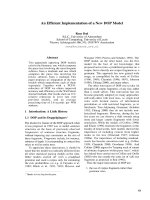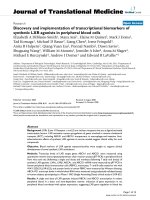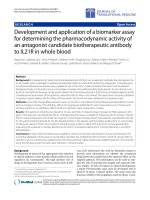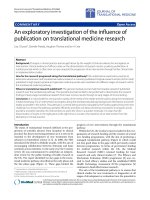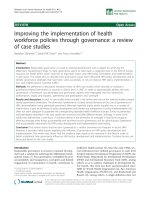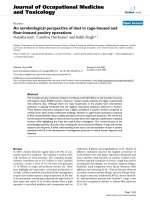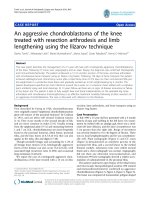Báo cáo toán học: " An efficient implementation of iterative adaptive approach for source localization" pptx
Bạn đang xem bản rút gọn của tài liệu. Xem và tải ngay bản đầy đủ của tài liệu tại đây (396.59 KB, 6 trang )
RESEARCH Open Access
An efficient implementation of iterative adaptive
approach for source localization
Gang Li
1*
, Hao Zhang
1
, Xiqin Wang
1
and Xiang-Gen Xia
2
Abstract
The iterative adaptive approach (IAA) can achieve accurate source localization with single snapshot, and therefore
it has attracted significant interest in various applications. In the original IAA, the optimal filter is performed for
every scanning angle grid in each iteration, which may cause the slow convergence and disturb the spatial
estimates on the impinging angles of sources. In this article, we propose an efficient implementation of IAA (EIAA)
by modifying the use of the optimal filtering, i.e., in each iteration of EIAA, the optimal filter is only utilized to
estimate the spatial components likely corresponding to the impinging angles of sources, and other spatial
components corresponding to the noise are updated by the simple correlation of the basis matrix with the
residue. Simulation results show that, in comparison with IAA, EIAA has significant higher computational efficiency
and comparable accuracy of source angle and power estimation.
Keywords: sparse recovery, iterative adaptive approach, source localization
1. Introduction
Source localization is a fundamental problem in a wide
range of applications including communications, radar,
and acoustics, and many algorithms have been presented
in the literature during recent decades. The Fourier-
based algorithms suffer from the low resolution and th e
high sidelobes. Some methods based on subspace pro-
cessing, e.g., Capon beamforming [1], MUSIC [2],
ESPRIT [3], and other subsp ace-based algorithms [4,5],
provide super-resolution for uncorrelated sources with
sufficient number of snapshots. However, in the case of
few snapshots, the performances of these subspace-
based methods will degrade sharply.
Recently, the source localization problem has been
converted into a sparse recovery framework, because the
number of actual sources of interest is generally much
smaller than the number of potential source locations in
the region to be observed. A kind of algorithms of
sparse r ecovery is based on iterative weighted least
squares, e.g., the FOCal Underdetermined System Solver
(FOCUSS) [6], the Sparse Learning via Iterative Minimi-
zation (SLIM) [7], the iterative adaptive approach (IAA)
[8], etc. Here, we are interested in IAA, which is able to
provide accurate source localization with single snapshot
and has attracted significant interest in various applica-
tions [9-11]. IAA is non-parametric and it achieves
accurate estimates of angles and powers of the sources
by iterative operations [8]. The spatial component on
every potential angle is estimated by optimal filtering,
which passes the signal from the current angle without
distortion and fully suppresses the interferences from
other angles. The iteration is terminated when the norm
of the difference between two successive spatial esti-
mates is smaller than a certain threshold. However, it is
time consuming to perform optimal filtering on all
potential angles, since in general we are only interested
in several angles where the actual sources are located.
Moreover, the excessive estimation of the spatial com-
ponents on the angles that are outside the actual source
position set may result in a slow convergence. In this
article, we propose an efficient implementation of IAA
(EIAA) by modifying the use of the optimal filtering, i.e.,
in each iteration, the optimal filter is only utilized to
estimate the spatial components likely corresponding to
the actual signal sources, and other s patial components
corresponding to the noise are updated by the simple
correlation of the basis matrix with the residue. It will
be shown that EIAA has significant faster convergence
* Correspondence:
1
Tsinghua National Laboratory for Information Science and Technology
(TNList), Department of Electronic Engineering, Tsinghua University, Beijing
100084, China
Full list of author information is available at the end of the article
Li et al. EURASIP Journal on Advances in Signal Processing 2012, 2012:7
/>© 2012 Li et al; licensee Springer. This is an Open Access article distributed under the terms of the Creative Commons Attribution
License ( which permits unrestricted use, distribution, and reprod uction in any medium,
provided the original work is properly ci ted.
speed and comparable ac curacy of source angle and
power estimation. In [12,13], two fast implementations
of IAA have been pr oposed by using the matrix compu-
tation technique such as Gohberg-Semencul decomposi-
tion, etc. It is noted that the way of the computational
burden reduction in this article is different from [12,13]:
herein, we focus on reducing the number of running
optimal filtering procedures, while [12,13] focus on
improving the co mputational efficiency of the optimal
filtering procedure. In addition, similar to the algorithms
mentioned above, we ar e only interested in the unam -
biguous angle solution, which depends on the ratio of
interelement spacing of the array to the wavelength. In
the case that the angle ambiguity occurs, we refer to
[14-16] for resolving the ambiguity.
The remainder of this article is organized as follows.
The signal model and the original IAA are introduced
in Section 2. The EIAA algorithm is proposed in Section
3. The pro posed EIAA is evaluated by some simulat ions
in Section 4. C oncluding remarks are presented in Sec-
tion 5.
2. Signal model and IAA
Suppose that K potential far-field narrowband signals
are impinging on an M-element array from directions
{θ
1
,θ
2
, ,θ
K
}. In single snapsh ot case, the outpu t mea-
surement vector of the array can be expressed as
y = As + e,
where A is the M × K basis matrix and is defined by
A =[a(θ
1
),a(θ
2
), ,a(θ
K
)], s is the K × 1 vector denoting
the complex amplitudes of the sources, e is the additive
noise. Considering an M-element linear array as shown
in Figure 1, the kth column of A corresponding to the
potential source direction θ
k
can be represented by
a(θ
k
)=[e
−j2πx
1
cos(θ
k
)/λ
, e
−j2πx
2
cos(θ
k
)/λ
, , e
−j2πx
M
cos(θ
k
)/λ
]
T
,
where {x
1
,x
2
, ,x
M
} are the positions of the M elements
of the array, respectively, l is the wavelength, (·)
T
denotes transpose. In sparse recovery framework, the
potential source number K is rather considered to be
the number of discretized anglegrids.Assumethats is
sparse, i.e., the number of actual sources is much smal-
ler than K . Consider the line-spectrum model and let P
=diag{p
1
,p
2
, ,p
K
}, whose kth diagonal element p
k
con-
tains the power at kth scanning angle grid. The problem
of interest is recovering the spatial components {p
1
,p
2
, ,
p
K
}, and the positions and the amplitudes of the peaks
of {p
1
,p
2
, ,p
K
} directly provide the locations and the
powers of the sources. IAA [8] achieves this goal as
summarized in Table 1 where the superscript (i) denotes
the ith iteration.
3. Efficient implementation of IAA
It is noted that step (b) in Table 1 gives an optimal filter
in terms of θ
k
, which reserves the signal from angle θ
k
without distortion and fully suppresses the interferences
(signals from other angles). In each iteration the optimal
filtering is performed K times for all a ngles {θ
1
,θ
2
, ,θ
K
}.
This is computationally extravagant, because in general
we are only interested in the angle set where the actual
sources are located. Moreover, for the index k corre-
sponding to θ
k
outside the angle set of actual sources,
p
k
most likely depends on the noise power, and the
iterative estimation of p
k
may increase the actual num-
ber of iterations required for the convergence. Based on
the above observations, we modify IAA as described in
Table 2.
The main difference between the proposed EIAA and
the original IAA lies in the estimation of spatial compo-
nents that are outside the actual sour ce location set. As
seen from step (b) i n Table 2 {θ
k
with index k Î Λ
(i)
}
are considered to be likely angle candidates where actual
sources are located. Then, the spatial components corre-
sponding to the actual source locations are updated by
optimal filtering, an d other spatia l components corre-
sponding to the noise are updated by simple correlation
of the columns of basis matrix with the residue. This
implies that the excessive estimation of noise compo-
nents is avoided. Compared with the original IAA, EIAA
can significantly reduce the computational burden
thanks to the following facts: (1) In each iteration, the
required times of optimal filtering procedure is equal to
the number of the selected principle components in step
(b) of Table 2. The step (b) of Table 2 is finished by the
residual energy threshold, for example, in practice it is
reasonable to let ξ = 0.05, which implies that the relative
residue energy is smaller than 5%. In high SNR case, it
is believable that the number of the selected principle
components i n step (b) of Table 2 is equal to the num-
ber of the actual sources ; for lower SNR, the number of
the selected principle components in step (b) of Table 2
may be slight lar ger than the number of t he actual
sources because the signal-subspace and the noise-sub-
space become undistinguishable. Anyway, the number of
the selected principle components, i.e., the re quired
times of optimal filtering procedure, is usually much
smaller than K, which is guaranteed by the prior
assumption of sparse signal property. (2) The relaxation
of the estimation of spatial components corresponding
to noise leads to stable and fast convergence.
4. Simulations
In this section, some examples are provided to evaluate
the performance of the proposed EIAA in single snap-
shot case. Consider a uniform linear array of M =14
Li et al. EURASIP Journal on Advances in Signal Processing 2012, 2012:7
/>Page 2 of 6
sensors with t he interelement spacing l/2. The addi-
tional noise is assumed Gaussian with zero mean and
variance s
2
, and the SNR is defined as
10l og
10
L
n=1
p
n
/(Lσ
2
)
.
The angle scanning grid is uniform in the range from 1°
to 180° with 1° increment between adjacent angle
candidates.
Assume that there are three sources at 52°, 70°, and
118° with p
1
=10dB,p
2
= 7 dB, and p
3
= 4 dB powers,
respectively.ForSNR=10dB,Figure2showsthespa-
tial estimates of IAA and EIAA. The true source loca-
tions are indicated by circles, and the results of ten
Monte-Carlo trials are plotted. One can see that both of
IAA and EIAA can ac curately indicate the locations and
powers of the sources, while EIAA shows sharper peaks.
The performances of IAA and EIAA are compared via
histograms over 1000 trials in Figure 3, where SNR = 5
dB for (a-c) and SNR = 10 dB for (d-f). The thresholds
inTable2aresetbyε =0.01andξ = 0.05. The source
localization error is defined by
er
angle
3
i=1
(
ˆ
θ
i
− θ
i
)
2
/3
and the
power estimation error is defined by
er
power
3
i=1
(
ˆ
p
i
− p
i
)
2
/3
.
Figure3a,b,d,erepresenthistogramsof
er
angle
EIAA
− er
angle
IAA
and
er
power
EIAA
− er
power
IAA
,andthetriangles
Figure 1 The geometry of sensors and sources.
Table 1 IAA algorithm
Initialization:
ˆ
p
(0)
k
=
a
H
(θ
k
)y
2
[a
H
(θ
k
)a(θ
k
)]
2
for k = 1,2, ,K.
Repeat:
(a) Calculate the correlation matrix by
ˆ
R
(i)
= A
ˆ
P
(i)
A
H
.
(b) Estimate the spatial components by
ˆ
p
(i)
k
=
a
H
(θ
k
) · (
ˆ
R
(i)
)
−1
· y
a
H
(θ
k
) · (
ˆ
R
(i)
)
−1
· a(θ
k
)
2
, for k = 1, 2, , K.
(c) If the norm of the difference between
ˆ
P
(i−1)
and
ˆ
P
(i)
is smaller than a threshold, i.e.,
δ
(i)
K
k=1
[
ˆ
p
(i−1)
k
−
ˆ
p
(i)
k
]
2
<ε
, the iteration is stopped;
otherwise let i = i+1 and go to a).
Li et al. EURASIP Journal on Advances in Signal Processing 2012, 2012:7
/>Page 3 of 6
indicate the cent roids of the histograms. It is obvio us
that most values of
er
angle
EIAA
− er
angle
IAA
and
er
power
EIAA
− er
power
IAA
are close to zero, which implies that EIAA is compar-
able with IAA in terms of the accuracy of angle and
power estimation. Moreover, the negative centroids indi-
cate that the estimation accuracy of EIAA is slightly bet-
ter than that of IAA. Figure 3c, f represent the
histograms of the running time ratio (RTR) of EIAA
and IAA, and the triangles indicate the histogram
centroids, and it can be seen EIAA is certainly faster
than IAA since all results of RTR are smaller than one.
Moreover, the centroids of RTR about 0.1 indicate that
the computational efficiency is significantly improved
by the proposed EIAA. For various SNR, the perfor-
mances of IAA and EIAA are compared in Table 3,
where each result is obtained by finding the centroid
position of the histogram over 500 trials (see triangle
position in Figure 3 for example). One can see that
Table 2 EIAA algorithm
Initialization: let
ˆ
p
(0)
k
=
a
H
(θ
k
)y
2
[a
H
(θ
k
)a(θ
k
)]
2
for k = 1,2, ,K; let the residue r
(0)
=y;
Repeat:
(a) Calculate the correlation matrix by
ˆ
R
(i)
= A
ˆ
P
(i)
A
H
;
Let the index support set Λ
(i)
= ∅ and the principal spatial component set Γ
(i)
= ∅.
(b) While the relative residue is larger than a threshold, i.e.,
r
(i)
2
2
y
2
2
>ξ
Find the index n
l
corresponding to the largest entry in the vector
[
ˆ
p
(i)
1
,
ˆ
p
(i)
2
, ,
ˆ
p
(i)
K
]
;
Expand the index support set by Λ
(i)
={Λ
(i)
, n
1
};
Expand the principal spatial component set by
(i)
=
⎧
⎪
⎨
⎪
⎩
(i)
,
a
H
(θ
n
l
) · (
ˆ
R
(i)
)
−1
· y
a
H
(θ
n
l
) · (
ˆ
R
(i)
)
−1
· a(θ
n
l
)
2
⎫
⎪
⎬
⎪
⎭
;
Calculate the residue by
r
(i)
= y − (A
H
(i)
A
(i)
)
−1
A
H
(i)
y
, where the matrix
A
(i)
consists of the columns of A with indices k Î Λ
(i)
;
Update the spatial estimate by
ˆ
p
(i)
k
=
a
H
(θ
k
)r
(i)
2
[a
H
(θ
k
)a(θ
k
)]
2
, for k = 1, 2, , K.
end While
(c) Restore the principal spatial components by
ˆ
p
(i)
k
=
(i)
(k)
, for k Î Λ
(i)
.
(d) If the norm of the difference between
ˆ
P
(i−1)
and
ˆ
P
(i)
is smaller than a threshold, i.e.,
δ
(i)
K
k=1
[
ˆ
p
(i−1)
k
−
ˆ
p
(i)
k
]
2
<ε
, the iteration is stopped;
otherwise let i = i+1 and go to a).
Figure 2 Spatial estimation results by 10 Monte-Carlo trials. (a) IAA estimates, (b) EIAA estimates.
Li et al. EURASIP Journal on Advances in Signal Processing 2012, 2012:7
/>Page 4 of 6
EIAA has slightly better angle and power estimation
accuracy than IAA. As for the computational effi-
ciency, the running time of EIAA is less than 15% of
that of IAA for various SNR.
5. Conclusion
In this article, EIAA algorithm is proposed for source
localization. By selecting the principal components of
spatial estimate in each iteration, the optimal filter is
Figure 3 Performance comparison of I AA and EIAA. (a-c) For SNR = 5 dB; (d-f) for SNR = 10 dB. (a, d) Angle error difference
er
angle
EIAA
− er
angle
IAA
; (b, e) power error difference
er
power
EIAA
− er
power
IAA
; (c, f) RTR of EIAA and IAA.
Li et al. EURASIP Journal on Advances in Signal Processing 2012, 2012:7
/>Page 5 of 6
only utilized to estimate the spatial components likely
corresponding to the actual signal sources, and the
other spatial components corresponding to noise are
updated by the simple co rrelation of the basis matrix
with the residue. Compared with the original IAA that
performs optimal filtering on every scanning angle grid
in each iteration, EIAA shows higher computational effi-
ciency and slightly better ac curacy of angle and power
estimation.
Acknowledgements
This study was supported in part by the National Natural Science
Foundation of China under Grant 40901157, and in part by the National
Basic Research Program of China (973 Program) under Grant 2010CB731901,
in part by the Doctoral Fund of Ministry of Education of China under Grant
200800031050, and in part by Tsinghua National Laboratory for Information
Science and Technology (TNList) Cross-discipline Foundation. Xia ’ s work was
supported by the National Science Foundation (NSF) under Grant CCF-
0964500 and the World Class Univerrsity (WCU) Program, National Research
Foundation, Korea.
Author details
1
Tsinghua National Laboratory for Information Science and Technology
(TNList), Department of Electronic Engineering, Tsinghua University, Beijing
100084, China
2
Department of Electrical and Computer Engineering,
University of Delaware, Newark, DE 19716, USA
Authors’ contributions
GL carried out the algorithm design and the drafted the manuscript. HZ and
XW participated in convergence analysis. X-GX participated in statistical
analysis. All authors read and approved the final manuscript.
Competing interests
The authors declare that they have no competing interests.
Received: 11 July 2011 Accepted: 12 January 2012
Published: 12 January 2012
References
1. J Capon, High resolution frequency-wavenumber spectrum analysis. Proc
IEEE. 57(8), 1408–1418 (1969)
2. RO Schmidt, Multiple emitter location and signal parameter estimation. IEEE
Trans Antenna Propagat. 34(3), 276–280 (1986). doi:10.1109/
TAP.1986.1143830
3. R Roy, T Kailath, ESPRIT–estimation of signal parameters via rotational
invariance techniques. IEEE Trans Acoust Speech Signal Process. 37(7),
984–995 (1989). doi:10.1109/29.32276
4. S Bourennane, C Fossati, J Marot, About noneigenvector source localization
methods. EURASIP J Adv Signal Process 13 (2008). Article ID 480835
5. Q Wang, Q Jiang, Simulation of matched field processing localization based
on empirical mode decomposition and Karhunen-Loeve expansion in
underwater waveguide environment. EURASIP J Adv Signal Process 7
(2010). Article ID 483524
6. IF Gorodnitsky, BD Rao, Sparse signal reconstruction from limited data using
FOCUSS: a re-weighted minimum norm algorithm. IEEE Trans Signal
Process. 45(3), 600–616 (1997). doi:10.1109/78.558475
7. X Tan, W Roberts, J Li, P Stoica, Sparse learning via iterative minimization
with application to MIMO radar imaging. IEEE Trans Signal Process. 59(3),
1088–1101 (2011)
8. T Yardibi, J Li, P Stoica, M Xue, AB Baggeroer, Source localization and
sensing: a nonparametric iterative adaptive approach based on weighted
least squares. IEEE Trans Aerospace Electron Syst. 46(1), 425–443 (2010)
9. W Roberts, P Stoica, J Li, T Yardibi, FA Sadjadi, Iterative adaptive approaches
to MIMO radar imaging. IEEE J Sel Topics Signal Process. 4(1), 5–20 (2010)
10. P Stoica, J Li, J Ling, Missing data recovery via a nonparametric iterative
adaptive approach. IEEE Signal Process Lett. 16(4), 241–244 (2009)
11. NR Butt, A Jakobsson, Coherence spectrum estimation from nonuniformly
sampled sequences. IEEE Signal Process Lett. 17(4), 339–342 (2010)
12. M Xue, L Xu, J Li, IAA spectral estimation: fast implementation using the
Gohberg-Semencul factorization. IEEE Trans Signal Process. 59(7), 3251–3261
(2011)
13. GO Glentis, A Jakobssony, Efficient implementation of iterative adaptive
approach spectral estimation techniques. IEEE Trans Signal Process. 59(9),
4154–4167 (2011)
14. J Sun, J Tian, G Wang, S Mao, Doppler ambiguity resolution for multiple
PRF radar using iterative adaptive approach. Electron Lett. 46(23),
1562–1563 (2010). doi:10.1049/el.2010.1865
15. G Li, J Xu, Y-N Peng, X-G Xia, An efficient implementation of a robust phase
unwrapping algorithm. IEEE Signal Process Lett. 14(6), 393–396 (2007)
16. W Wang, X-G Xia, A closed-form Robust Chinese Remainder Theorem and
its performance analysis. IEEE Trans Signal Process. 58(11), 5655–5666 (2010)
doi:10.1186/1687-6180-2012-7
Cite this article as: Li et al.: An efficient implementation of iterative
adaptive approach for source localization. EURASIP Journal on Advances
in Signal Processing 2012 2012:7.
Submit your manuscript to a
journal and benefi t from:
7 Convenient online submission
7 Rigorous peer review
7 Immediate publication on acceptance
7 Open access: articles freely available online
7 High visibility within the fi eld
7 Retaining the copyright to your article
Submit your next manuscript at 7 springeropen.com
Table 3 Performances of IAA and EIAA for various SNR
SNR 0 dB 5 dB 10 dB 15 dB 20 dB
er
angle
EIAA
− er
angle
IAA
-0.297° -0.114° -0.107° -0.015° -0.004°
er
power
EIAA
− er
power
IAA
-0.087 -0.393 -0.543 -0.489 -0.373
RTR of EIAA and IAA 0.131 0.118 0.081 0.072 0.070
Li et al. EURASIP Journal on Advances in Signal Processing 2012, 2012:7
/>Page 6 of 6
